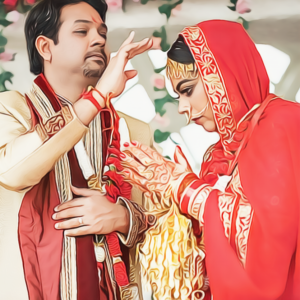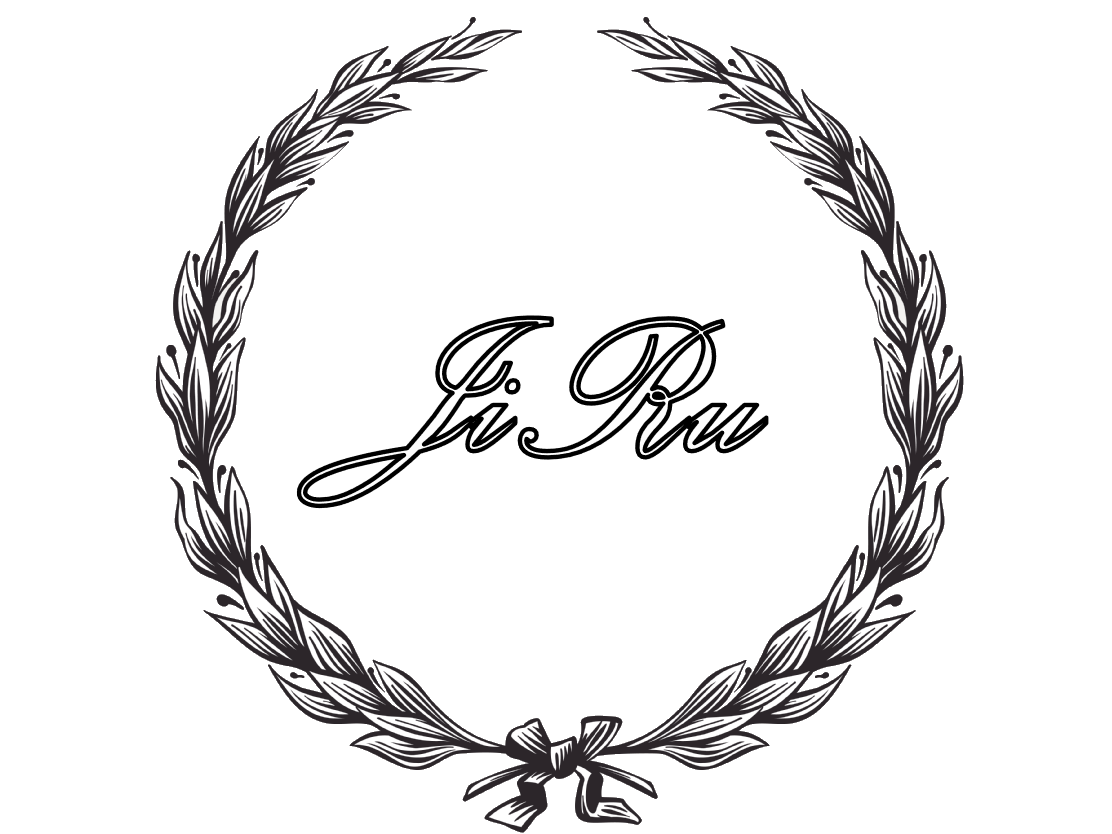Hindu Wedding Ceremony Overview
In Hinduism, marriage joins two individuals for the purpose of jointly pursuing the four aims of life: dharma, artha, kama, and moksha
01
Var Āgamān or Swāgatam – Welcoming of the Groom
The bride’s mother welcomes the groom, often with a vermillion forehead marking (kumkum tilak), waving of a diya, or earthen lamp on a decorative plate, a small offering of jaggery or sugar, sprinkling water and rice in all directions. The groom will then step onto a clay vessel crushing it to pieces, assuring the parents that he has the ability, strength, and determination to overcome all obstacles that the couple may face in their married life.
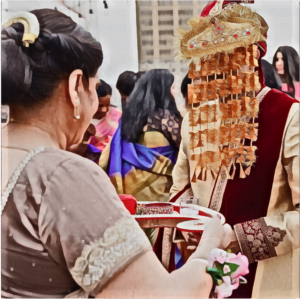
02
Ganesha Pujā – Prayers to the Remover of Obstacles
Nearly every rite of passage, weddings being no exception, begin with an invocation to Lord Ganesh, the Remover of Obstacles and embodiment of knowledge and auspicious endeavors. This ceremony invites him after symbolically purifying the surroundings and ritual participants. Rice, flowers, and fruit may be offered as a sign of hospitality and worshipful respect to the deity.
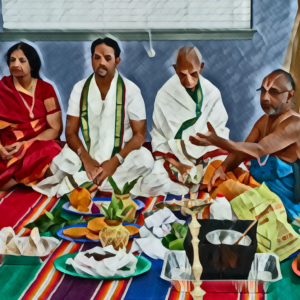
03
Kalash Pujā
A kalash is a copper pot which is filled with water and often topped with leaves and a coconut. The priest invokes water, from all rivers and oceans, which is purified with Vedic mantras and used throughout the ceremony. This is followed by the worship of the five elements of Creation.
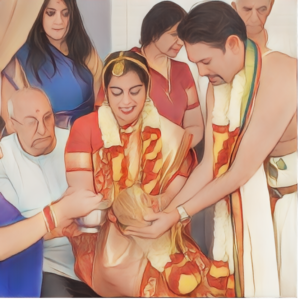
04
Kanyā Āgamān
The bride is escorted to the mandap (altar). A mandap, which is a wedding canopy with four poles, represents a variety of things including the Purusharthas, the four stages of life, the four walls of a home, and the four parents of the couple, without whose support, love and blessings, the marriage would not have come to take place. Traditionally, the mandap is built of wood or bamboo and decorated. Decorations may range from simple garlands of flowers and banana leaves to embroidered silks and intricate mirror-work.
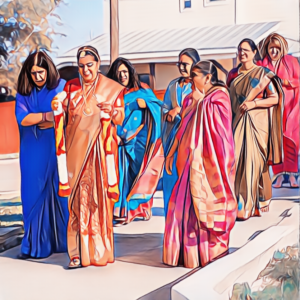
05
Antarpat and Jaimala
The antarpat (curtain) is held in front of the groom, signifying that the bride and groom are still two independent individuals and mangalashtakam (sacred hymn) is recited. The antarpat is then removed, and the couple exchange garlands in a ritual called Jaimala to symbolize their acceptance of one another.
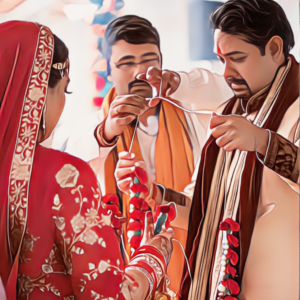
06
Kanyā Pratigrahan – Presenting of the bride
A kalash is a copper pot which is filled with water and often topped with leaves and a coconut. The priest invokes water, from all rivers and oceans, which is purified with Vedic mantras and used throughout the ceremony. This is followed by the worship of the five elements of Creation.

07
Pānigrahan or Hasta Melap
The right hands of the bride and groom are joined, and the ends of scarves worn by the bride and groom are tied together signifying their unity.
Vara Mālā
A garland with 24 threads is placed on the bride and the groom by the parents to endorse their union.
Granthi Bandhan
A lace is tied to garments of the couple to signify unity.
Agni Sthāpana
The priest lights the fire invoking the presence of Lord Agni as the impartial witness to the ceremony.
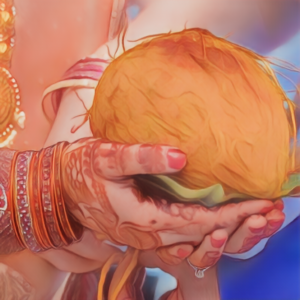
08
Vivāha Homa
Both the bride and groom walk in a clockwise direction four times representing the four goals of life:
- Dharma: A sense of goodness, balance, and universal well-being
- Artha: A sense of security and material prosperity
- Kama: A sense of mental and physical happiness
- Moksha: A sense of wholeness, which comes through spiritual freedom and our endeavors
Traditionally, the groom leads the bride in the first three rounds. The bride, representing Shakti, the Divine Energy, leads in the last round. At the end of each round the bride’s brother or cousin brother gives offerings for the fire. The first three represent the material wealth of cows, silver, and gold. The last offering represents the gift of the bride herself to her new family. At the end of the ceremony, the bride stands to the groom’s left, where she has taken a place closest to his heart. Hindu couples from particular regions make seven rounds which include the four described above as well as one for harmonious life and healthy progeny, another for purity, strength, and the last for blessings for devotion, companionship, and unity.
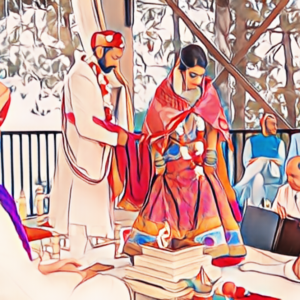
09
Saptapadi (Seven Steps Together)
The bride and groom take seven steps together to signify the beginning of their journey as husband and wife. They promise:
- May we take the first step together for nourishment
- May we take the second step together for vigour
- May we take the third step together for thriving wealth
- May we take the fourth step together for comfort
- May we take the fifth step together for offspring
- May we take the sixth step together for the various seasons
- May we take the seventh step together for everlasting friendship
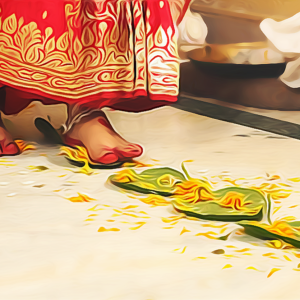
10
Sindoor and Mangalsutra
The groom applies sindoor (vermillion) to the bride’s forehead and welcomes her as his partner for life. The groom also offers her a mangalsutra (a sacred black bead necklace). The bride and groom are now united and seek the blessings of Lord Vishnu (the Preserver) and Goddess Lakshmi (the Goddess of Prosperity and Well-being).
Āshirvād and Blessings
The priest and the families bless the newlyweds.
Kanyā Vidāi
This is optional and up to the discretion of the bride and her family. This symbolic ceremony facilitates the progression from a bride to a wife.
